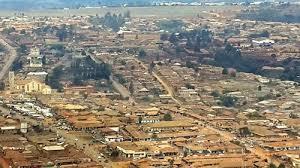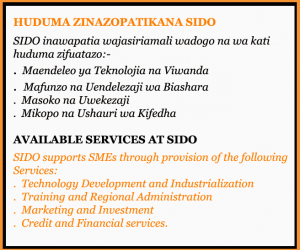
NJOMBE REGION IN BRIEF
1.1 Geographical Location
Njombe Region was established on 1st March 2012 by the Government Gazette No.9 under order No.72. The region is located in Southern Highlands Zone which comprises of Ruvuma, Iringa, Mbeya, Katavi, Rukwa Regions and part of Morogoro Region. It borders Iringa Region in the North, Morogoro Region in the East and Ruvuma region in the South. It also borders Republic of Malawi via Lake Nyasa and part of Mbeya Region in the North-West and West. It lies between latitude 08o 40’ and 10o 32’ South of the Equator and between longitude 33o 47’ and 35o 45’ East of Greenwich. This spatial location of the region offers unique advantages to investors in two main ways:
(a) as a logistical hub with connections to all directions of Tanzania and beyond borders with reasonably developed transport infrastructural facilities by road, railway, water and air. Very few regions in Tanzania have that advantage;
(b) a combination of conducive weather and soil types suited for tropical and temperate crops and livestock.
1.2. Administrative Units
The Region is divided into four districts namely Njombe, Wanging’ombe, Makete and Ludewa. Also there are six Local Government Authorities namely Njombe and Makambako Town Councils, Njombe, Makete, Wanging’ombe and Ludewa District Councils. There are a total of 18 Divisions, 96 Wards, 384 Villages and 35 Mitaa.
1.3 Land Area
The Region has the total surface area of 24,994 sq. km out of which 21,172 sq. km is covered by land (84.7 percent) and 3,822 sq. km is covered by water (15.3 percent).This implies the region has opportunism for both land and water-based economic activities for potential investors to select from. Ludewa district is unique as it endowed with a vast coast line along Lake Nyasa with ports to link to Ruvuma and Mbeya regions with Tanzania, and to neighboring Malawi. There is a huge opportunity for investment in both tourism facilities and passenger/cargo transport vessels.
1.4 Climate
The regional climate is influenced by a number of factors which have led to the formation of three climatic zones namely, the Highlands Zone, the Midlands Zone and the Lowlands zones. The Highlands Zone lies at an altitude of 1,600 – 3,000 meters above sea level. This area includes Imalinyi in Wanging’ombe district, Lupembe in Njombe district, Mlangali, Liganga and part of Mawengi Division in Ludewa and Makete districts. Temperature is normally below 15o C with rainfall ranging from 1,000 to 1,600 mm per annum, falling in a single season from November through May, The dry and cold season occurs after the rain season, and it lasts from June to September.
The Midlands Zone lies between 700 – 1,700 meters above sea level. This area includes Ludewa and Njombe Town and Northern parts (Lupembe and Makambako) with rainfall ranges between 1,100 and 1,300mm and temperature are mild to cold falling to below 100C during June-July.
The lowland zone lies between 600 – 1,400 metres above sea level. This area includes Mdandu and Wanging’ombe Divisions in Wanging’ombe District, Masasi and Mwambao Divisions in Ludewa District and Mfumbi Ward in Makete District. Temperature is between 150C and 200C with rainfall ranging from 600 to 1000mm, with occasional mild droughts in 4 out of 5 years.
The variation in climatic conditions in terms of temperature and rainfall patterns offers investors opportunities to diversify their agricultural (e.g. horticulture) and livestock products (e.g. milk and wool) to take advantage of low seasonal supplies in other parts of Tanzania, East and Southern Africa and the world market in general.
1.5 Human Capital and Population Characteristics
According to 2012 Population and Housing Census, the Region had 702,097 people, 329,359 being males and 372,738 females with average annual growth rate of 0.8%.
1.6 Drainage system
The Region forms the major catchment areas of the three main rivers of Ruhudzi in Njombe District, Ruhuhu in Ludewa District and Ruaha which flows from Kipengere ranges in Makete District. The region especially in Southern part drains water into Lake Nyasa while Eastern and Western tributaries drain water into Great Ruaha River which pours to Rufiji River into the Indian Ocean. As an investor, you will be expected to contribute to sustainable environmental management by observing established codes of conduct as part of corporate social responsibility. It should be noted that the rivers originating from the region are responsible for the generation of about a third of hydropower electricity in Tanzania. There are several identified sources of mega and minor hydropower sources, whose profile is already prepared by Tanzania National Electricity Supply Company (TANESCO) and the Ministry of Energy and Minerals. There are opportunities to buy shares in already established hydropower generating ventures owned by Tanzanians. New investment will therefore be located at the centre of current electricity generation in the country.
1.7 Agro-ecological zones
The region has three agro-ecological zones, namely; Highlands, Middle and Lowland. Some parts of the lowlands are within the great rift valley, offering the region a unique combination of agro-ecological combinations from very cold to very warm temperatures, high to low humidity conditions and from temperate type of vegetation to tropical and savannah type of forest cover. Most of the cereals are produced in low lands and midland, while cash crops such as pyrethrum, tea and coffee are produced from the midlands and highlands. There is also potential for cashew production in some low lying areas such as Masasi Division in Ludewa district.
The diversity of agro-ecological conditions offers investors in the agricultural sector a wide margin for coping with emerging challenges of climate change. Among the newly introduced commodities, which had low economic value a decade ago, include water melons (lowlands), avocados, apples, pineapples and flowers (middle and highland areas).
2.0 REGIONAL ECONOMIC DATA
2.1 Overall wealth of the region
The region is ranked among the most economically endowed in the country, with a per capita income among the top regions after Dar es salaam. This is generally reflected in the quality of rural houses and means of production, whereby almost all fields are prepared either by tractor or animal traction. The region is a leading supplier of soft timber and
round potatoes in the country. More than 20 buses leave Njombe, Makete and Ludewa to other parts of the country, especially Dar-es-salaam, Iringa, Songea and Mbeya, on a daily basis, indicating active economic networking of its people with the rest of the country.
2.2 Agriculture
Agriculture has continued to dominate the livelihood and economic activities of the people in the region, whereby about 90 percent of the population earn their living from the sector. So far weather conditions continue to be the major determinant of agricultural performance in the region as a proportionally small area is irrigated, mostly for rice, horticultural crops (mostly onions and tomatoes) and tea production. The region is among the major maize producers in the country, competing with Mbeya, Ruvuma, Iringa, Rukwa, Morogoro, Kigoma and Katavi regions.
The region’s total land is estimated to be 2,117,200.0 hectares out of which 1,090,000 hectares is an arable land, but only 513,594 Ha (47.1%) of the arable land is under cultivation. The latter includes an annual average of 415,396 hectares of food crops and about 98,198 Hectares under cash crops. Thus, the region has a large untapped land resource that requires development in terms of crop production either by peasant or commercial farmers. The largest proportion of the region’s cultivated area is owned by peasants who cultivate an average area of 0.8 hectares per household. The Region is also the major producer of round potatoes and wheat.
2.2.1 Irrigation schemes
The Region has potential area for irrigation of about 15,632 hectares but only 4,016 hectares (25.7%) are under irrigation. The irrigated land in the region has been developed and used for commercial tea and flower farms and small scale irrigation farming. Main crops being irrigated by small scale farmers are round potatoes, maize, vegetables, tomatoes, paddy and beans. Also, it has to be noted that some of small scale farmers practice irrigation through cultivation of bottom land commonly known as “vinyungu”.
2.3 Livestock
Livestock keeping in the region is mainly traditional and comprised almost of indigenous Zebu cattle. Livestock keeping is one of lucrative economic activities in the region and plays most significant economic role in the lives of the rural population after agriculture.
2.4 Forestry
The region is covered by 496,627 Hectares of forest which is about 27.14 percent of the regional land area. This includes natural forests of 109,948 Hectares and tree plantations of 196,128 Hectares. Plantations comprise Eucalyptus, Pines, Black wattle and Cypress. The total area covered by forest plantation in 2013 is about 386,679 Hectares.
2.5 Tourism and Wildlife
There are several tourism attractions in the Region. These attractions include the Kipengere and Livingstone mountain ranges (natural vegetation and landscape views). Others include hospitality industry, cultural packages and historical products in tourism attractions, such as the old German Bomas Milo Ludewa, old Missionary churches by Germans at Luilo, Madunda and Lugalawa in Ludewa and Yakobi in Njombe District.
2.6 Beekeeping
The natural reserve along Mpanga-Kipengere and parts of Ludewa district like Mavanga, Mundindi, Ludende, Milo, Mawengi, Mbwila Ibumi and all wards along Lake Nyasa provide some opportunity for investment in beekeeping and honey production and link with small scale farmers to supply honey and beeswax. Currently the Region has about 64,786 beehives with production of 58,233 litres and 5,005 kilograms of honey and bee wax respectively per year. The endowment of plenty of water in Lake Nyasa and presence of Miyombo woodlands and Montane rain forests in the region is an opportunity for beekeeping activities in the area.
2.7 Mineral Resources
Njombe is among the regions in Tanzania endowed with mineral resources. Little is known about the actual potential of the minerals with the exception of coal and iron ore deposits at Mchuchuma and Liganga respectively, in Ludewa District where these mineral deposits have extensively been studied. Apart from coal and iron ore deposits, Ludewa District is endowed with many other mineral including gold, copper and gemstone especially tourmaline. Makete district is also endowed with iron ore in Lupila and Ukwama wards; Kaolin in Mlondwe and Matamba wards; Gold in Mfumbi, Lupalilo, Lupila and Kigulu wards; and, Platinum in Kitulo ward. Other minerals include Copper, Manganese, Chrome, Talc, Soap and Stone.


